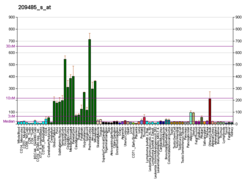| OSBPL1A |
|---|
|
| Identifiers |
|---|
| Aliases | OSBPL1A, ORP-1, ORP1, OSBPL1B, oxysterol binding protein like 1A |
|---|
| External IDs | OMIM: 606730; MGI: 1927551; HomoloGene: 84746; GeneCards: OSBPL1A; OMA:OSBPL1A - orthologs |
|---|
| Gene location (Human) |
|---|
 | | Chr. | Chromosome 18 (human)[1] |
|---|
| | Band | 18q11.2 | Start | 24,162,045 bp[1] |
|---|
| End | 24,397,880 bp[1] |
|---|
|
| Gene location (Mouse) |
|---|
 | | Chr. | Chromosome 18 (mouse)[2] |
|---|
| | Band | 18|18 A1 | Start | 12,888,371 bp[2] |
|---|
| End | 13,074,898 bp[2] |
|---|
|
| RNA expression pattern |
|---|
| Bgee | | Human | Mouse (ortholog) |
|---|
| Top expressed in | - corpus callosum
- internal globus pallidus
- inferior ganglion of vagus nerve
- postcentral gyrus
- external globus pallidus
- subthalamic nucleus
- pons
- pars reticulata
- lateral nuclear group of thalamus
- occipital lobe
|
| | Top expressed in | - prefrontal cortex
- deep cerebellar nuclei
- barrel cortex
- medial geniculate nucleus
- primary motor cortex
- medial dorsal nucleus
- pontine nuclei
- lateral geniculate nucleus
- medial vestibular nucleus
- olfactory epithelium
|
| | More reference expression data |
|
|---|
| BioGPS | 
 | | More reference expression data |
|
|---|
|
| Gene ontology |
|---|
| Molecular function | - cholesterol binding
- protein binding
- phospholipid binding
- lipid binding
- sterol transporter activity
- sterol binding
| | Cellular component | - endosome
- late endosome
- intracellular anatomical structure
- extracellular exosome
- cytosol
- membrane
- intracellular membrane-bounded organelle
| | Biological process | - lipid transport
- cholesterol metabolic process
- antigen processing and presentation of exogenous peptide antigen via MHC class II
- vesicle-mediated transport
- bile acid biosynthetic process
- sterol transport
- transport
| | Sources:Amigo / QuickGO |
|
| Orthologs |
|---|
| Species | Human | Mouse |
|---|
| Entrez | | |
|---|
| Ensembl | | |
|---|
| UniProt | | |
|---|
| RefSeq (mRNA) | |
|---|
NM_001242508
NM_018030
NM_080597
NM_133268 |
| NM_001252489
NM_001252490
NM_001252491
NM_001252492
NM_001252493
|
|---|
NM_020573
NM_207530 |
|
|---|
| RefSeq (protein) | |
|---|
NP_001229437
NP_060500
NP_542164 |
| NP_001239418
NP_001239419
NP_001239420
NP_001239421
NP_001239422
|
|---|
NP_997413 |
|
|---|
| Location (UCSC) | Chr 18: 24.16 – 24.4 Mb | Chr 18: 12.89 – 13.07 Mb |
|---|
| PubMed search | [3] | [4] |
|---|
|
| Wikidata |
| View/Edit Human | View/Edit Mouse |
|



















